| The world of Marvel
superheroes had in many ways revolutionized the
comic book medium since 1961. It featured
individuals who in spite (or even because) of
their superhero powers had to continuously deal
with their very own problems in life. Since that
was part of the success formula, it would always
be clear what exactly the problem was. Similarly,
one could always tell the good guys from the bad
guys, and at the end of the day good would
prevail and crime would never pay. It was a clean
world, made up of primary colours, and although
there were plenty of physical clashes, blood was
never and bruises hardly ever to be seen. But throughout the 1960s the real
world was changing into a far more complex place.
Social questions and political issues made it
harder and harder to figure out or agree on what
the problems really were, and the line between
good and bad became blurred at times. Some comic
books tried to adapt to this increasingly gloomy
reality, but the superhero concept started to
feel simply too clean to a growing number of
readers - who even started writing in to Marvel,
asking for non-superhero fare (NN, 2010).
A number of publishers
started to realize that they needed to find a way
to renew their appeal to existing as well as new
comic book readers. One way of doing this was to expand into
different genres, and among these, horror stories and characters had
always been popular in times of
economic and social crises, allowing people to
project their real-life fears onto the threats
posed by vampires and ghouls and haunted houses.
Not surprisingly, horror movies had seen a sharp
surge in popularity since the mid-1960s. As far
as comic books were concerned, the shock of the
1954 US Senate hearings and subsequent culling of
EC Comics and other publishers putting out horror
titles had passed, and the days of the highly
restrictive Comics Code were clearly numbered.
|
| |
| In the early to
mid-1960s, DC Comics had followed the trend set by
Marvel and revamped its horror titles to
feature superheroes (such as Manhunter
from Mars in House of Mystery #143
- 155 [June 1964 - December, 1966] and
Dial H for Hero in House of Mystery
#156 - 173 [January 1966 - March/April
1968]). Noting
horror's resurging popularity, DC's newly
appointed Editorial Director
Carmine Infantino
acted
on the trend and brought EC Comics
veteran Joe Orlando into the DC ranks.
Appointed editor for House of Mystery,
the title once again began to feature
horror stories, and as of issue #174,
Orlando introduced Cain, the "able
care taker" of the House, followed
later by Abel in the same role for
the
House of
Secrets as of issue #81 (August
1969).
Based rather
obviously on classic EC prototypes such
as the Crypt Keeper, the characters
served as "narrators with an
attitude" (Cooke, 1998) and -
combined with covers depicting classic
horror and gothic themes and visuals -
made both titles an instant success.
"Neal
[Adams] did the best covers for House
of Mystery. Many times he would walk
in with a sketch that he had thought
up himself and I would often get a
story written for the sketch."
(Joe Orlando in Cooke, 1998)
|
|
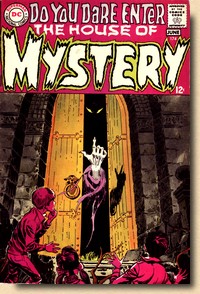
House
of Mystery #174
(May/June 1968)
|
|
| |
| While the first few revamped issues of House
of Mystery featured a combination of
reprints with "passable new strips"
(Roach, 2001), Orlando soon stepped up the game
by bringing on board the creative talent of Neal
Adams, Alex Toth and Bernie Wrightson and turned
the title into a massive seller. Within a year,
DC had expanded its horror line to no less than
five titles: House of Mystery, House of
Secrets. Unexpected, Witching Hour and Phantom
Stranger. |
| |
| |
MARVEL'S
TOWER OF SHADOWS &
CHAMBER OF DARKNESS
|
| |
For the first time in
years, DC had managed to be ahead of the House of
Ideas - a fact which did not go unnoticed at
Marvel.
"DC was having some luck
with House of Mystery and House of Secrets
(...) so it was a natural to try to get back
into the genre again." (Roy
Thomas in Cooke, 2001)
|
| |
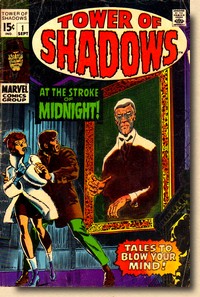
Tower of Shadows #1
(September 1969)
|
|
Marvel
launched Tower of Shadows #1 in
September 1969 and Chamber of Darkness
#1 in October 1969.
Reviving its own horror
genre heritage was carried out by
assigning some of its biggest talents to
the new task, including writer-artists Neal
Adams, Jim Steranko and Wally Wood,
writer-editor Stan Lee himself, and
renowned artists such as John Buscema,
Gene Colan, Don Heck, Barry Smith and
George Tuska.
The result was
top quality content for which Marvel was
rewarded at the 1969 New York Comic Art
Convention when Jim Steranko's lead story
for the first issue of Tower of
Shadows ("At the Stroke of
Midnight") won an Alley Award
for best feature story.
But in spite of
all of the great talent invested, neither
Tower of Shadows nor its sister
title Chamber of Darkness went on
to become highly successful titles -
simply because Marvel lacked the means to
provide effective editorship.
|
|
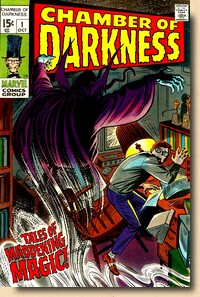
Chamber of Darkness #1
(October 1969)
|
|
| |
"[The]
problem was that, after the first
issue or two, with our being too busy
to pay a lot of attention to them,
they didn't have the focus Joe
Orlando could give to the DC books by
concentrating on a handful of titles
(...) so we just tried to hire a
bunch of people to do good stories.
But they didn't ever have any unity
(...) we really didn't have anybody
that really concentrated on that
editorially." (Roy Thomas
in Cooke, 2001)
Just as Orlando
had unapologetically done for DC's
House
of Mystery and House of Secrets,
both
Tower of Shadows and Chamber
of Darkness also made obvious
references to the classic EC horror
comics by featuring a host for each story
- such as Roderick
"Digger" Krupp (a gravedigger)
or "Headstone" P. Gravely (an
undertaker). Both characters could have
come straight from a 1950's horror comic
and thus fitted that tradition nicely.
|
|
| |
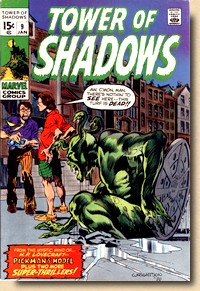
Tower
of Shadows #9
final issue
(January 1971)
|
|
But in spite of all the effort
invested, sales only went from
average to poor, making the
necessary commitment (the two
horror titles were far more
demanding in terms of editorship
in comparison to other books,
requiring three different sets of
writers and artists for every
issue) untenable.
"We
didn't have the right kind of
a set-up at the time to make
a hit of those books."
(Roy Thomas in:
Cooke, 2001)
As a
result, Marvel gradually stopped
producing original material and
began inserting more and more
reprints of 1950s monster and
sci-fi stories from the Atlas
archives as of issues #6 of both
Tower
of Shadows and
Chamber
of Darkness. Both titles soon
spun out of existence after this.
After nine issues,
Tower
of Shadows became Creatures
on the Loose in March 1971, featuring a mix
of reprints and occasional sword
and sorcery and sci-fi series
(and introducing characters
such as Kull or John Carter
Warrior of Mars) before finally
being cancelled after issue #37
in September 1975.
|
|
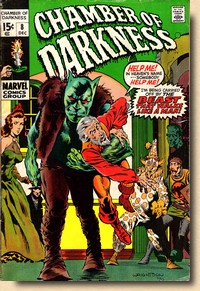
Chamber
of Darkness #8
final issue
(December 1970)
|
|
|
| |
| Similarly,
Chamber of Darkness became
Monsters on the Prowl with issue #9 in
February 1971, turning much into the same
direction of sword and sorcery as its companion
title as of issue #16 in April 1972 before
cancellation came in October 1974.
Over at DC, things went
much more smoothly.
House
of Mystery continued its run and eventually
clocked up a staggering 321 issues and an
incredible 32 years in publication before the
lights went out in October 1983. Its sister
title, House of Secrets, would also
outlive Marvel's anthology books by far with a
total of 74 issues before cancellation in
November 1978.
Marvel tried to stay on
board with the horror genre but, based on the
experience with Tower of Shadows and Chamber
of Darkness, decided to go for reprint
titles only,
mostly
sourced from 1950s and very early 1960s issues of
Journey into Mystery, Strange Tales, Tales to
Astonish and Tales of Suspense.
However, success was still limited and, in
comparison to DC's figures, meagre: With only 38
issues under its belt, Where Monsters Dwell
(launched in January 1970) became the
longest running Marvel anthology reprint title
before being dropped in October 1975.
It would take Marvel a
moment to figure out how to make the horror genre
work for its readership, and the answer would be
the "superhero from the crypt" in the
shapes and forms of Ghost Rider, Werewolf by
Night and Tomb of Dracula as well as black &
white magazines.
|
| |
|
| |
|
| |
| |
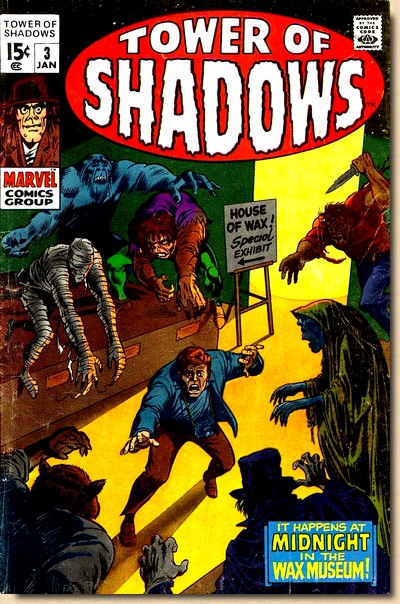 |
|
Editor -
Stan
Lee
Cover
pencils - Marie
Severin
Cover inks -
Frank
Giacoia
"The
Moving Finger Writhes...!"
(7
pages)
Story
- Len Wein
Art - Gene Colan
Inks - Mike Esposito (as
Joe Gaudioso)
Lettering -
Jean
Izzo, Morrie
Kuramoto
"Midnight
in the Wax Museum!"
(7
pages)
Story
-Gary Friedrich
Art & Inks - George
Tuska *
Lettering -
Jean
Izzo
*
Gary
Friedrich caricature and parts of
page 3 by Marie Severin
"The
Terrible Old Man!"
(7
pages)
Story
- Roy Thomas
(adapted from a story by H. P.
Lovecraft)
Art - Barry Windsor-Smith
Inks - Dan Adkins,
Joe Verpoorten
Lettering -
Jean
Izzo
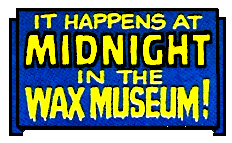
|
|
|
| |
| Tower of Shadows
#3, cover dated January 1970, went on sale 21
October 1969. For the 15¢ buyers plopped down in
those days, they still got a total of 21 story
pages - in this case divided up evenly over the
three stories, all of which was original
material, i.e. brand new.
Both the writing and artwork were
provided by established as well as new talent:
Roy Thomas, George Tuska and Gene Colan were
joined by relative newcomers Gary Friedrich (who
had started out at Marvel in 1967 writing Western
material), Len Wein (this being his very first
story for Marvel after some previous work for DC)
and Barry Windsor-Smith (whose first work for
Marvel was X-Men #53 in late 1968),
while Jean Izzo (the daughter of long-time Marvel
letterer Artie Simek) had started lettering for
Marvel in 1967.
While "The Terrible Old Man" is an
authorised adaptation by Roy Thomas of the
identically titled short story by H. P. Lovecraft
(originally published in 1921 and part of the
Cthulhu mythos), the other two entries "The
Moving Finger Writhes...!" and
"Midnight in the Wax Museum!" employ
similarly classic horror plots and twists.
|
| |
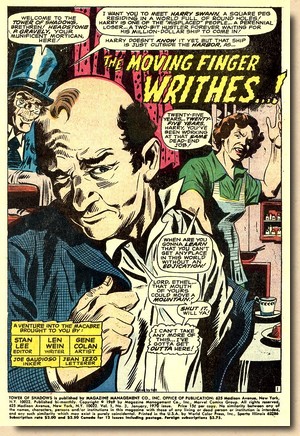 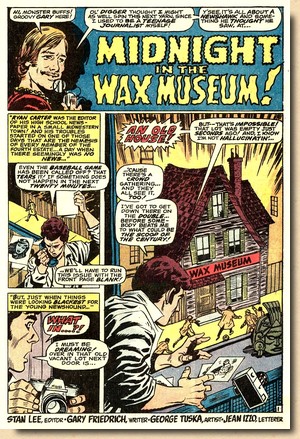 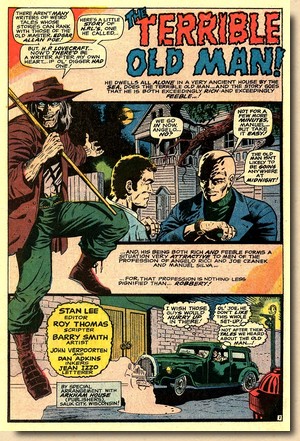 |
| |
| In "The Moving Finger Writhes...!"
a certain Harry Swann, constantly berated by his
wife for working at a dead end job, finds and
buys a book entitled The Life and Times of
Harry Swann at a rare books shop. Shockingly,
it is a literal transcription of his entire
life's history, but Harry soon discovers that
some chapters pertain to events that have yet to
take place, and following these he turns his
fortune around by making a fortune placing bets
at the racetrack on horses that he knows will
win. But even with this newly found wealth his
wife keeps nagging, so Harry again follows the
book and tampers with the brakes of his wife's
car, who then dies in an accident. On his way
back from the funeral, Harry is held up due to
some construction work and, in order to pass the
time, skims through the book again - but
confusingly, the pages are now blank. It is at
this moment that a falling iron beam crushes him
to death. One of the work men at the site,
Charlie Jenkins, picks up the book when he
realizes that the cover reads The Life and
Times of Charlie Jenkins. Curious about his
strange new discovery, he wanders off and begins
reading the book... Somewhat less elaborate,
"Midnight in the Wax Museum!" tells the
story of an ambitious reporter who witnesses
strange events in conjunction with an alien
landing, but of course nobody believes him and he
ends up being considered out of his mind. What
does set this little tale apart from the two
others is the fact that the narrator isn't
Headstone A. Gravely or Digger, but rather
"Groovy Gary" - that is to say Gary
Friedrich, the author of this yarn.
|
| |
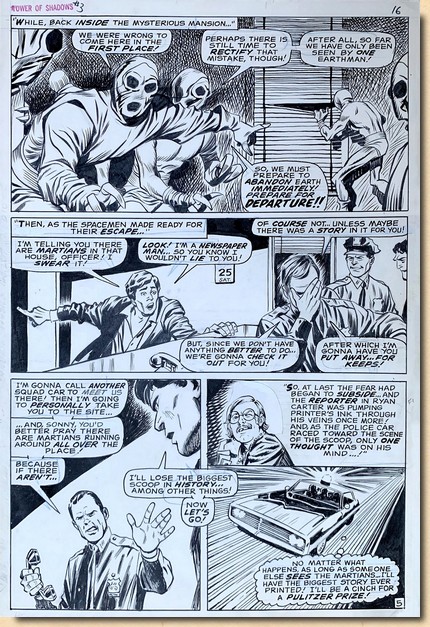
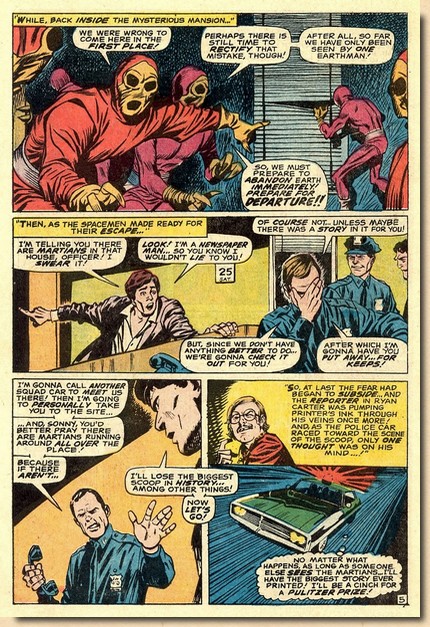
Original
artwork by George Tuska (pencils and
inks) for page 5 of "Midnight in the Wax
Museum!" from Tower Of
Shadows #3 (scanned from the original),
and the same page as it appeared in
print.
|
|
| |
| In a way, it
was a natural chain of thought for Marvel - if
you are talking to the readers and introducing
stories, why use fictional characters when you
could just as well feature the individuals who
actually produced the story? |
| |
|
Not
surprisingly, it started with
"Smilin'" Stan Lee
himself as host and narrator for
Roy Thomas' adaptation of Edgar
Allan Poe's short story The Masque of
the Red Death in
Chamber
of Darkness #2 (December 1969).
The idea
caught on in a flash, with Gary
Friedrich being the second in
line here but by no means the
last (other such cameos included artists Don Heck
and Gene Colan in Tower of
Shadows #4, Tom Sutton
in Chamber
of Darkness #4, Roy Thomas and
Tom Palmer in Tower of
Shadows #9 , and Bill
Everett and Dan Adkins in
Chamber
of Darkness #8).
However,
a closer look at the original
artwork reveals that having Stan
Lee and Garry Friedrich as hosts
was an afterthought, coming late
in the production process of Chamber
of Darkness #2 - the artwork
was already fully lettered and
inked when the idea popped up.
|
|
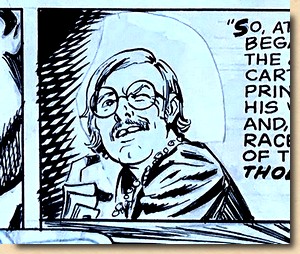
|
|
|
| |
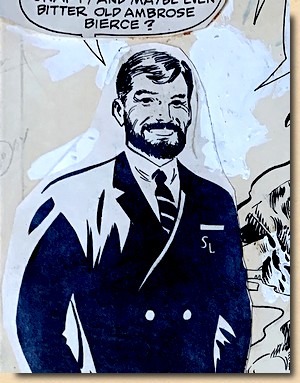
Stan Lee as host in Chamber
of Darkness #2 (December
1969), scanned from the original
artwork
|
|
As a result,
paste-ups were used over the
already completed artwork. In the
case of
Chamber
of Darkness #2, Don Heck's
original image of Headstone A.
Gravely was covered by a stat of
a portrait of Stan Lee by Marie
Severin, whose many talents
included drawing amazing
caricatures of virtually every
Marvel staffer to ever have set
foot in the Bullpen.
In
addition, the already finished
lettering in the word balloons
was covered and corrected in
places to fit the new host - all
of which is quite evident on the
original artwork. The
inspirational source for the
drawing of Lee himself quite
clearly seems to be a well-known
official 1968 photograph, right
down to the tie Lee is wearing.
The
original artwork for Tower of
Shadows #3 reveals a similar
process, where the head of Gary
Friedrich (again the work of
Marie Severin) has been pasted
onto the host originally drawn by
George Tuska.
Stan
Lee, of course, loved to play
around with the fictional reality
of a comic book story and the
real world. A prime example is
his self-portrayal in his
real-life job as a comic book
editor caught up in a fictional
encounter with what is a very
thinly veiled real-life Dr
Wertham in Suspense #29
(April 1953). And of course the
same principles apply when Stan
Lee and Jack Kirby - portrayed as
comic book writer and artist
within a comic book they actually
wrote and pencilled - are visited
by none other than Dr Doom in Fantastic
Four #10 (January 1963) or
are both refused entry to Reed
Richards and Sue Storm's wedding
in Fantastic Four Annual
#3 (December 1965).
|
|
|
| |
| So was it Lee's idea to feature himself as
the host of a story in an anthology horror title,
followed by further writers and artists in
subsequent issues of Tower Of Shadows
and Chamber Of Darkness? The answer may
be lost to comic book history, but it certainly
was, as they say, a
nice idea that certainly made for the perfect
icing on what was already quite an exquisite
cake. Unfortunately, it did not turn out to be
the flavour of the day. Tower Of
Shadows also sported a letters page (aptly
named "Tomes from the Tower!"), and on
this occasion, editorial was keen to point out
that Marvel had not nicked the idea of having a
host from rival DC (as one reader insinuated) but
that the concept went back to the classic EC
comics.
|
| |
Other
than that, Tower Of Shadows #3
included the usual fan-loved fare in the
form of in-house ads (such as promoting
the latest Avengers and Thor
issues as "2 more Triumphs from
Marvel") as well as the Bullpen
Bulletin (titled "A Sagacious
Smattering of Somewhat Senseless
Small-Talk!" this time around) and
the Mighty Marvel Checklist (which on
this occasion actually mentioned Tower
Of Shadows #3).

|
|
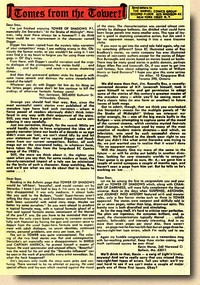
|
|
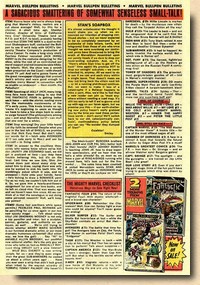
|
|
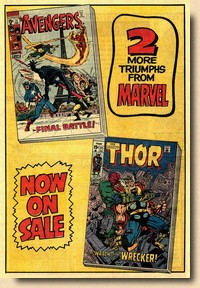
|
|
| |
| |
|